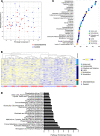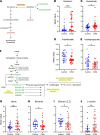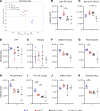REP1 deficiency causes systemic dysfunction of lipid metabolism and oxidative stress in choroideremia
- PMID: 33755601
- PMCID: PMC8262314
- DOI: 10.1172/jci.insight.146934
REP1 deficiency causes systemic dysfunction of lipid metabolism and oxidative stress in choroideremia
Abstract
Choroideremia (CHM) is an X-linked recessive chorioretinal dystrophy caused by mutations in CHM, encoding for Rab escort protein 1 (REP1). Loss of functional REP1 leads to the accumulation of unprenylated Rab proteins and defective intracellular protein trafficking, the putative cause for photoreceptor, retinal pigment epithelium (RPE), and choroidal degeneration. CHM is ubiquitously expressed, but adequate prenylation is considered to be achieved, outside the retina, through the isoform REP2. Recently, the possibility of systemic features in CHM has been debated; therefore, in this study, whole metabolomic analysis of plasma samples from 25 CHM patients versus age- and sex-matched controls was performed. Results showed plasma alterations in oxidative stress-related metabolites, coupled with alterations in tryptophan metabolism, leading to significantly raised serotonin levels. Lipid metabolism was disrupted with decreased branched fatty acids and acylcarnitines, suggestive of dysfunctional lipid oxidation, as well as imbalances of several sphingolipids and glycerophospholipids. Targeted lipidomics of the chmru848 zebrafish provided further evidence for dysfunction, with the use of fenofibrate over simvastatin circumventing the prenylation pathway to improve the lipid profile and increase survival. This study provides strong evidence for systemic manifestations of CHM and proposes potentially novel pathomechanisms and targets for therapeutic consideration.
Keywords: Genetic diseases; Metabolism; Ophthalmology.
Conflict of interest statement
Figures







References
Publication types
MeSH terms
Substances
Grants and funding
LinkOut - more resources
Full Text Sources
Other Literature Sources
Molecular Biology Databases
Research Materials

